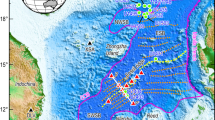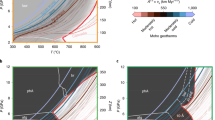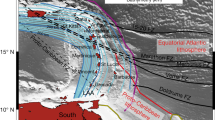Abstract
Water, the most abundant volatile in Earth’s interior, preserves the young surface of our planet by catalysing mantle convection, lubricating plate tectonics and feeding arc volcanism. Since planetary accretion, water has been exchanged between the hydrosphere and the geosphere, but its depth distribution in the mantle remains elusive. Water drastically reduces the strength of olivine1 and this effect can be exploited to estimate the water content of olivine from the mechanical response of the asthenosphere to stress perturbations such as the ones following large earthquakes. Here, we exploit the sensitivity to water of the strength of olivine2, the weakest and most abundant mineral in the upper mantle, and observations of the exceptionally large (moment magnitude 8.6) 2012 Indian Ocean earthquake3 to constrain the stratification of water content in the upper mantle. Taking into account a wide range of temperature conditions and the transient creep of olivine, we explain the transient deformation in the aftermath of the earthquake that was recorded by continuous geodetic stations along Sumatra as the result of water- and stress-activated creep of olivine. This implies a minimum water content of about 0.01 per cent by weight—or 1,600 H atoms per million Si atoms—in the asthenosphere (the part of the upper mantle below the lithosphere). The earthquake ruptured conjugate faults down to great depths4, compatible with dry olivine in the oceanic lithosphere. We attribute the steep rheological contrast to dehydration across the lithosphere–asthenosphere boundary, presumably by buoyant melt migration to form the oceanic crust.
This is a preview of subscription content, access via your institution
Access options
Subscribe to this journal
Receive 51 print issues and online access
$199.00 per year
only $3.90 per issue
Buy this article
- Purchase on Springer Link
- Instant access to full article PDF
Prices may be subject to local taxes which are calculated during checkout




Similar content being viewed by others
References
Karato, S.-I., Paterson, M. S. & Fitzgerald, J. D. Rheology of synthetic olivine aggregates—influence of grain size and water. J. Geophys. Res. 91, 8151–8176 (1986)
Karato, S. & Wu, P. Rheology of the upper mantle: a synthesis. Science 260, 771–778 (1993)
Yue, H., Lay, T. & Koper, K. D. En echelon and orthogonal fault ruptures of the 11 April 2012 great intraplate earthquakes. Nature 490, 245–249 (2012)
Wei, S., Helmberger, D. & Avouac, J.-P. Modeling the 2012 Wharton basin earthquakes off Sumatra: complete lithospheric failure. J. Geophys. Res. 118, 3592–3609 (2013)
Hirschmann, M. M. Water, melting, and the deep Earth H2O cycle. Annu. Rev. Earth Planet. Sci. 34, 629–653 (2006)
Hill, E. et al. The 2012 M w 8.6 Wharton Basin sequence: a cascade of great earthquakes generated by near-orthogonal, young, oceanic mantle faults. J. Geophys. Res. 120, 3723–3747 (2015)
Bürgmann, R. & Dresen, G. Rheology of the lower crust and upper mantle: evidence from rock mechanics, geodesy, and field observations. Annu. Rev. Earth Planet. Sci. 36, 531–567 (2008)
Bruhat, L., Barbot, S. & Avouac, J. P. Evidence for postseismic deformation of the lower crust following the 2004 M w 6.0 Parkfield earthquake. J. Geophys. Res. 116, B08401 (2011)
Rousset, B., Barbot, S., Avouac, J. P. & Hsu, Y.-J. Postseismic deformation following the 1999 Chi-Chi earthquake, Taiwan: implication for lower-crust rheology. J. Geophys. Res. 117, B12405 (2012)
Rollins, J. C., Barbot, S. & Avouac, J.-P. Mechanisms of postseismic deformation following the 2010 El Mayor-Cucapah earthquake. Pure Appl. Geophys. 54, 1305–1358 (2015)
Hirth, G. & Kohlstedt, D. L. in Inside the Subduction Factory (ed. Eiler, J. ), Vol. 138, 83–105 (Geophysical Monographs, AGS, 2003 ).
Karato, S. & Jung, H. Effects of pressure on high temperature dislocation creep in olivine. Phil. Mag. 83, 401–414 (2003)
Gaherty, J. B., Jordan, T. H. & Gee, L. S. Seismic structure of the upper mantle in a central pacific corridor. J. Geophys. Res. 101, 22291–22309 (1996)
Montagner, J.-P. & Tanimoto, T. Global anisotropy in the upper mantle inferred from the regionalization of phase velocities. J. Geophys. Res. 95, 4797–4819 (1990)
Hanson, D. R. & Spetzler, H. A. Transient creep in natural and synthetic, iron-bearing olivine single crystals: mechanical results and dislocation microstructures. Tectonophysics 235, 293–315 (1994)
Chopra, P. High-temperature transient creep in olivine rocks. Tectonophysics 279, 93–111 (1997)
Karato, S.-I. in Ice Age Geodynamics: A New Perspective (ed. Wu, P. ) 351–364 (Trans Tech Publications, 1998)
Freed, A. M., Herring, T. & Bürgmann, R. Steady-state laboratory flow laws alone fail to explain postseismic observations. Earth Planet. Sci. Lett. 300, 1–10 (2010)
Pollitz, F. F. Transient rheology of the uppermost mantle beneath the Mojave desert, California. Earth Planet. Sci. Lett. 215, 89–104 (2003)
Wang, K., Hu, Y. & He, J. Deformation cycles of subduction earthquakes in a viscoelastic earth. Nature 484, 327–332 (2012)
Raj, R. Transient behavior of diffusion-induced creep and creep rupture. Metall. Trans. A 6, 1499–1509 (1975)
Mackwell, S. J., Kohlstedt, D. L. & Paterson, M. S. The role of water in the deformation of olivine single crystals. J. Geophys. Res. 90, 11319–11333 (1985)
Barbot, S. & Fialko, Y. A unified continuum representation of postseismic relaxation mechanisms: semi-analytic models of afterslip, poroelastic rebound and viscoelastic flow. Geophys. J. Int. 182, 1124–1140 (2010)
Müller, R., Sdrolias, M., Gaina, C. & Roest, W. Age, spreading rates, and spreading asymmetry of the world’s ocean crust. Geochem. Geophys. Geosyst. 9, Q04006 (2008)
Barbot, S., Fialko, Y. & Bock, Y. Postseismic deformation due to the M w 6.0 2004 Parkfield earthquake: stress-driven creep on a fault with spatially variable rate-and-state friction parameters. J. Geophys. Res. 114, B07405 (2009)
Marone, C., Scholz, C. H. & Bilham, R. On the mechanics of earthquake afterslip. J. Geophys. Res. 96, 8441–8452 (1991)
Hirth, G. & Kohlstedt, D. L. Water in the oceanic upper mantle: implications for rheology, melt extraction and the evolution of the lithosphere. Earth Planet. Sci. Lett. 144, 93–108 (1996)
Karato, S. Does partial melting reduce the creep strength of the upper mantle? Nature 319, 309–310 (1986)
Naif, S., Key, K., Constable, S. & Evans, R. Melt-rich channel observed at the lithosphere–asthenosphere boundary. Nature 495, 356–359 (2013)
Karato, S. Rheology of the earth’s mantle: a historical review. Gondwana Res. 18, 17–45 (2010)
Feng, L. et al. A unified GPS-based earthquake catalog for the Sumatran plate boundary between 2002 and 2013. J. Geophys. Res. 120, 3566–3598 (2015)
Ranalli, G. Transient creep in the upper mantle. Il Nuovo Cimento C 3, 405–419 (1980)
Hart, E. A phenomenological theory for plastic deformation of polycrystalline metals. Acta Metall. 18, 599–610 (1970)
Poirier, J.-P. Shear localization and shear instability in materials in the ductile field. J. Struct. Geol. 2, 135–142 (1980)
Chinh, N. Q., Horvath, G., Horita, Z. & Langdon, T. G. A new constitutive relationship for the homogeneous deformation of metals over a wide range of strain. Acta Mater. 52, 3555–3563 (2004)
Voce, E. The relationship between stress and strain for homogeneous deformation. J. Inst. Met. 74, 537–562 (1948)
Andrade, C. E. N. On the viscous flow in metals, and allied phenomena. Proc. R. Soc. Lond. A 84, 1–12 (1910)
Karato, S.-I. Deformation of Earth Materials: An Introduction to the Rheology of Solid Earth 34–39 (Cambridge Univ. Press, 2008)
Delescluse, M. & Chamot-Rooke, N. Instantaneous deformation and kinematics of the India–Australia plate. Geophys. J. Int. 168, 818–842 (2007)
Delescluse, M. et al. April 2012 intra-oceanic seismicity off Sumatra boosted by the Banda–Aceh megathrust. Nature 490, 240–244 (2012)
Hayes, G. P., Wald, D. J. & Johnson, R. L. Slab1.0: a three-dimensional model of global subduction zone geometries. J. Geophys. Res. 117, B01302 (2012)
Barbot, S., Fialko, Y. & Sandwell, D. Three-dimensional models of elasto-static deformation in heterogeneous media, with applications to the eastern California shear zone. Geophys. J. Int. 179, 500–520 (2009)
Barbot, S. & Fialko, Y. Fourier-domain Green’s function for an elastic semi-infinite solid under gravity, with applications to earthquake and volcano deformation. Geophys. J. Int. 182, 568–582 (2010)
Mei, S. & Kohlstedt, D. L. Influence of water on plastic deformation of olivine aggregates: 2. Dislocation creep regime. J. Geophys. Res. 105, 21471–21481 (2000)
Jin, D., Karato, S. & Obata, M. Mechanisms of shear localization in the continental lithosphere: inference from the deformation microstructures of peridotites from the Ivrea zone, northwestern Italy. J. Struct. Geol. 20, 195–209 (1998)
Behr, W. M. & Platt, J. P. Brittle faults are weak, yet the ductile middle crust is strong: implications for lithospheric mechanics. J. Geophys. Res. 41, 8067–8075 (2014)
Tarantola, A. Inverse Problem Theory and Methods for Model Parameter Estimation 1–37 (SIAM, 2004)
Sambridge, M. Geophysical inversion with a neighbourhood algorithm—I. Searching a parameter space. Geophys. J. Int. 138, 479–494 (1999)
Freed, A. M., Hirth, G. & Behn, M. D. Using short-term postseismic displacements to infer the ambient deformation conditions of the upper mantle. J. Geophys. Res. 117, 2156–2202 (2010)
Pollitz, F. F. Post-earthquake relaxation evidence for laterally variable viscoelastic structure and water content in the Southern California mantle. J. Geophys. Res. 120, 2672–2696 (2015)
Wei, S. et al. The 2014 Mw 6.1 South Napa earthquake: a unilateral rupture with shallow asperity and rapid afterslip. Seismol. Res. Lett. 86, 344–354 (2015)
Chlieh, M. et al. Coseismic slip and afterslip of the great Mw 9.15 Sumatra-Andaman earthquake of 2004. Bull. Seismol. Soc. Am. 97, S152–S173 (2007)
Konca, A. et al. Rupture kinematics of the 2005 Mw 8.6 Nias-Simeulue earthquake from the joint inversion of seismic and geodetic data. Bull. Seismol. Soc. Am. 97, S307–S322 (2007)
Acknowledgements
We are grateful to our LIPI collaborators who maintain the SuGAr network, including J. Encillo, I. Suprihanto, D. Prayudi and B. Suwargadi. Raw SuGAr data are available for download at ftp://eos.ntu.edu.sg/SugarData. We thank M. Sambridge for sharing his Neighborhood Algorithm software. The modelling software used in this study is hosted at www.geodynamics.org/cig/software/relax with support from the Computational Infrastructure for Geodynamics. This research was supported by the National Research Foundation of Singapore under the NRF Fellowship scheme (National Research Fellow Awards numbers NRF-NRFF2013-04 and NRF-NRFF2010-064) and by the Earth Observatory of Singapore, the National Research Foundation, and the Singapore Ministry of Education under the Research Centres of Excellence initiative. This is EOS publication 120.
Author information
Authors and Affiliations
Contributions
S.M., S.D.B. and S.-i.K. conducted the study and wrote the manuscript. L.F. prepared the GPS time series. P.B. develops the SuGAr network.
Corresponding author
Ethics declarations
Competing interests
The authors declare no competing financial interests.
Additional information
Reviewer Information: Nature thanks G. Hirth and W. Thatcher for their contribution to the peer review of this work.
Extended data figures and tables
Extended Data Figure 1 Time series of GPS displacements at the Sumatra GPS Array stations.
The effect of previous earthquakes, their postseismic relaxation, and other spurious effects have been modelled and removed from the data (black vertical line labelled ‘12/8.6’ for the year and magnitude of the earthquake). The resulting time series isolate the postseismic transient following the 2012 Mw 8.6 Indian Ocean earthquake. The (arbitrary) colours indicate the GPS stations. The vertical lines mark the onset of the postseismic transient. The methodology for data preparation is described in refs 6 and 31.
Extended Data Figure 2 Effect of transient creep of olivine on postseismic transients.
a, Creep tests. We compare relaxation tests that include the transient creep of olivine (solid red profile) with the response at steady-state for power-law (dashed blue profile) and linear (dashed black profile) viscoelastic materials. The stress perturbation and relaxation times are chosen to highlight typical behaviours. The resulting strain, stress and time are non-dimensionalized. The transient creep accelerates the initial response, but slows down the subsequent relaxation. b, Effect of transient creep on models of postseismic relaxation following the Indian Ocean earthquake. Inclusion of transient creep accelerates the deformation at stations BNON and BSIM, other parameters being the same. c, Role of the hardening coefficient GK on models of postseismic deformation with transient creep at GPS station BSIM. The hardening coefficient controls how much stress is relaxed by transient creep and how long the effect is sustained. The hardening coefficient GK in our models for the Wharton basin is equal to the background rigidity.
Extended Data Figure 3 Comparison of the stress changes caused by earthquakes at 100 km depth.
Data is from the 2012 Mw 8.6 Indian Ocean4 earthquake and the 2004 Mw 9.2 Aceh–Andaman52 and the 2005 Mw 8.6 Nias53 earthquakes (coloured beach balls) at 100 km depth. The stress change due to the giant and great Sunda megathrust earthquakes is one to two orders of magnitude lower than the one due to the 2012 event in the Wharton basin asthenosphere. The negligible effect of the megathrust events is due to their stress changes concentrating below the megathrust and in the mantle wedge. In addition, some of this stress has been relaxed in the many years that separate the events.
Extended Data Figure 4 Simulation of the surface postseismic displacements after one year due to stress-driven afterslip on the Indian Ocean coseismic faults.
The predicted horizontal displacements (white arrows) are aligned with the GPS observations (black arrows), but the modelled vertical displacements (background colours) are opposite to those measured by GPS (coloured circles).
Extended Data Figure 5 Benchmark of the Bayesian inversion method for water content in olivine.
We produce a synthetic data set of GPS time series at the SuGAr network (inset in a and black profile with uncertainties in b) assuming the afterslip parameter V0 = 3 × 10−6 m s−1, a water content of COH = 1,000 H atoms per million Si atoms, and no transient creep. c, The bivariate probability density for water content and the afterslip parameter has a maximum at the target value of the model parameters and documents the tradeoffs between model parameters. a, Conditional probability density along the red horizontal profile in c and marginal probability density of water content in olivine. d, Conditional probability density along the red vertical profile in c and marginal probability density of the afterslip parameter. In principle, the spatial distribution of the SuGAR GPS stations with one year of data provides an unbiased estimate of the water content in the asthenosphere.
Extended Data Figure 6 Probability density of water content in olivine from assimilation of the SuGAr time series of postseismic deformation and prior information from geochemical estimates.
a, The bivariate probability density of water content and the afterslip parameter. There are few tradeoffs between the two parameters. b, Prior (black profile), marginal (blue profile) and conditional (dashed red profile) probability densities of the afterslip parameter. The prior distribution is 1/V0, that is, the limit of no prior information for Jeffrey’s parameters47. c, Prior information, marginal and conditional probability densities for water content in olivine. The prior density is a log-normal distribution with a mean value of 600 H atoms per million Si atoms and a standard deviation of 1.
Extended Data Figure 7 Observed (blue squares with uncertainties) and modelled (red profiles) GPS time series of postseismic displacements after the 2012 Mw 8.6 Indian Ocean earthquake.
The figure shows all the SuGAr time series available and considered in the study. Left, horizontal displacements. Right, vertical displacements. The model reproduces the subtle uplift of the forearc island stations in the Northern Hemisphere and the temporal evolution of displacements at most stations. The small misfit at some stations (Fig. 2d) can be attributed to the model-simplifying assumptions such as no reactivation of the Sunda megathrust or the Sumatran fault and no internal deformation in the accretionary prism.
Rights and permissions
About this article
Cite this article
Masuti, S., Barbot, S., Karato, Si. et al. Upper-mantle water stratification inferred from observations of the 2012 Indian Ocean earthquake. Nature 538, 373–377 (2016). https://doi.org/10.1038/nature19783
Received:
Accepted:
Published:
Issue Date:
DOI: https://doi.org/10.1038/nature19783
This article is cited by
-
Recurrence time and size of Chilean earthquakes influenced by geological structure
Nature Geoscience (2024)
-
Heterogeneous rheology of Japan subduction zone revealed by postseismic deformation of the 2011 Tohoku-oki earthquake
Progress in Earth and Planetary Science (2023)
-
Dynamics and Evolution of Venus’ Mantle Through Time
Space Science Reviews (2022)
-
MCMC inversion of the transient and steady-state creep flow law parameters of dunite under dry and wet conditions
Earth, Planets and Space (2021)
-
Dislocation interactions in olivine control postseismic creep of the upper mantle
Nature Communications (2021)
Comments
By submitting a comment you agree to abide by our Terms and Community Guidelines. If you find something abusive or that does not comply with our terms or guidelines please flag it as inappropriate.



